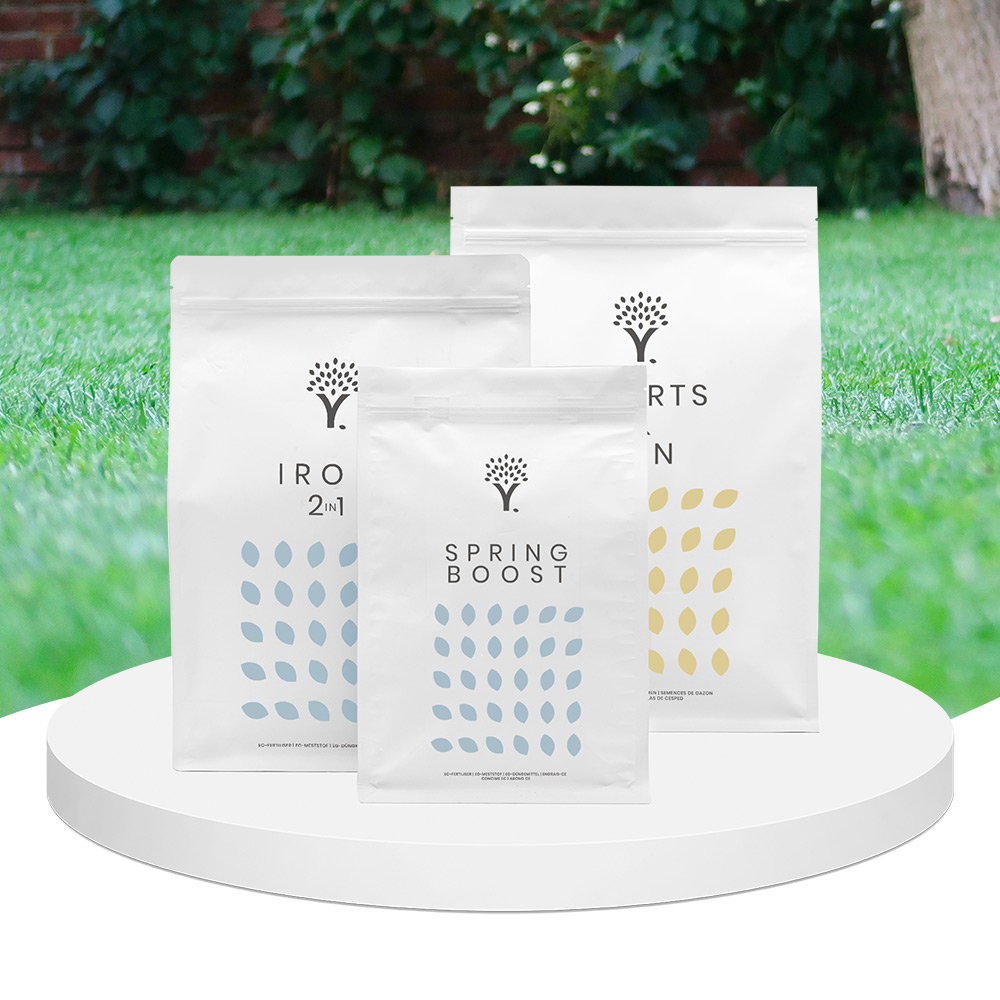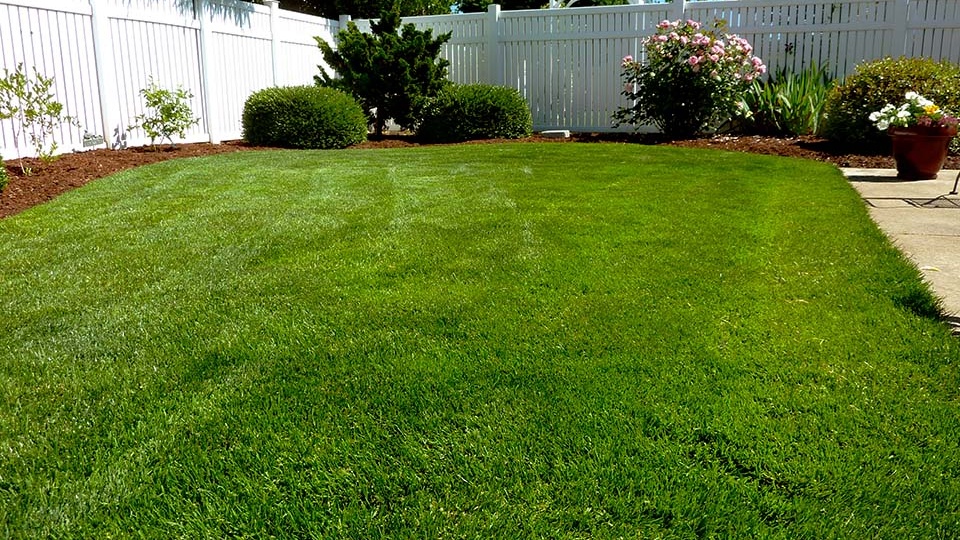Log in or create new account to save this product to your wishlist.
How to get rid of moss: THE Lawn Moss Killer Guide of 2023
Moss is the spongy stuff that yields as you step onto your grass. It might feel quite pleasant to walk on, BUT it will kill your lawn if it takes hold. Find out how to tackle moss for a more beautiful lawn
Latest articles
7 MIN 22 Jul How to keep your lawn in shape this summer 9 MIN 15 Jul Watering Your Garden: 10 Top Tips! 11 MIN 15 Jul Is Your Grass Type Right for your Garden? 11 MIN 10 Sep Create Your Low-Maintenance Garden – Tips and Ideas 11 MIN 08 Sep The Ultimate Guide to Choosing the Perfect Hedges for Your Garden 12 MIN 30 Aug The Top 20 Evergreen Climbers to Transform Your GardenIs your lawn covered with spongy green moss? Perhaps, when you look really closely, your lawn blades are thinning out, replaced by a carpet of invasive green or brown lichen? You need lawn moss killer.
Applying lawn moss killer helps you restore your waning lawn.
Moss is both a problem and a gauging stick for the health of your lawn. This is because it spreads into a thick layer on top of the soil, growing between the individual grass plants, making it difficult to get oxygen down to the roots of your grass. The presence of moss on your lawn is a sign of the general weakness of your grass.
There are many reasons why moss develops. This article explores WHY moss loves your garden and how to kill it off for a more beautiful, robust lawn that can withstand the challenges of the changeable British weather.
The causes of moss in your lawn

Moss loves a poorly maintained lawn where the grass is thin and the soil malnourished. These conditions allow moss and weeds to get the upper hand.
It might feel like a vicious circle: a poor lawn encourages more moss, and more moss weakens your grass even further.
However, it’s possible to overcome the problem in a variety of ways.
The following conditions contribute to the development of moss in your lawn:
- Acidic or compacted soil
- Poor air circulation
- Stodgy, wet soil
- Poor drainage
- Malnourished soil
- Bad lawn maintenance
Luckily, none of these conditions are insurmountable.
So, on top of regular mowing and fertilising, there are several ways to kill the moss on your lawn.
Lawn Moss Killer: Fight moss naturally
There are some fairly harsh chemical treatments on the market which will kill off the moss in your lawn. But chemicals can be harmful to your soil and the wildlife that relies on your garden for sustenance.
We always recommend going green. It’s better to protect the environment by fighting moss the natural way.
TIP 1 | Create more light & air:
Moss loves the shade, which is why it tends to develop enthusiastically around large trees and below shady fences and buildings.
So, if possible, create more light and air for your lawn.
Those low-hanging branches create the perfect ecosystem for unwanted moss, so prune them back and open up the canopy. This offers more light and air circulation to your lawn, making a less hospital home for moss and weeds. It’s the natural lawn moss killer!
TIP 2 | Increase soil fertility:

Most moss species thrive in poor soil conditions. They love acidic soils and earth with depleted nutrients. On the other hand, a healthy lawn needs nutritious, pH-balanced soil.
Perform a soil analysis to find out your lawn soil needs.
Acidic soil blocks the nutrient absorption of plants like grass. This stunts the growth of your lawn while encouraging the development of moss.
Use Lawn Lime to neutralise your soil’s pH, increase fertility, and create a less hospitable environment for moss. Lawn Lime acts as a more natural lawn moss killer than harsh chemical solutions.
Or you could choose a Lawn Moss Killer which contains everything your lawn needs to recover after killing off the moss. All soil becomes acidic over time. This is because dead organic material (such as fallen leaves and garden waste) breaks down, producing an acidic mulch that raises your topsoil’s pH level.
Iron Plus 2-in-1 fertiliser and moss killer
Iron Plus 2-in-1 fertiliser and moss killer colours your grass a deep, lush green, helping the lawn recover after its winter dormancy. Iron sulphate is suitable for all lawn types (with or without moss).
-
The causes of moss in your lawn -
Lawn Moss Killer: Fight moss naturally -
TIP 1 | Create more light & air: -
TIP 2 | Increase soil fertility: -
TIP 3 | Correct pH: -
TIP 4 | Aerating compact soil: -
TIP 5 | Verticutting / scarifying: -
Lawn Moss Killer: Fight it chemically
TIP 3 | Correct pH:
Perform a pH test. It’s a simple process that takes very little time.
The ideal pH level for a healthy lawn is between 5.5 and 6.5. Neutralising the soil’s acidity optimises the earth for healthy lawn growth and prepares it for better nutrient absorption.
And, remember: strong grass growth is the most natural lawn moss killer! Strong grass prevents moss.
TIP 4 | Aerating compact soil:

Compacted soil hinders root development which causes a thinning of the grass blades, making way for the moss.
Regularly aerating the soil helps nutrients, water, and oxygen reach the roots of your lawn.
Test your soil texture: squeeze a handful of soil in your hand for a couple of seconds, and then open your palm.
If the soil crumbles easily, you have a sandy soil (which is well-drained but struggles to hold onto nutrients). If the soil is compacted and clay-like, you have a heavy clay soil (which is poorly drained but nutrient-rich).
Sprinkle compost and sand over clay soils for better aeration or rent an aeration machine that will churn up compacted soil for better oxygen penetration.
You can aerate your soil with an aerating machine or using aeration sandals as shown in the image above.
TIP 5 | Verticutting / scarifying:
Once moss is present in your lawn, you need to remove it manually or mechanically before grass can grow in its place.
Scarifying is the process of removing moss from the surface of the lawn. One way of scarifying is to mow your lawn vertically (also called “verticutting”).
Verticutting combs out the dead material and allows you to cut the sideways-growing shoots of your grass, creating a natural boost in growth hormone.
Verticutting helps remove the moss and gives your waning grass a fresh boost of natural hormones.
After verticutting, your lawn will look a little thin. Make it bounce back by providing the nutrients and grass seed it needs to recover.
Lawn Moss Killer: Fight it chemically
Moss spreads in a variety of ways, but the most effective is wind and insect dispersal. You have to be careful when you manually remove moss because you could release microscopic spores that actually spread the moss even further.
You can use the following products to prevent reseeding the moss as you disturb it. (Please note that these products kill the moss, but if the root cause of the problems goes unaddressed, moss will always return.)
Copper Sulphate:
Copper sulphate is dissolved in water and applied to the moss with the help of a backpack sprayer. This particular chemical compound can stain porous materials badly, so use old gloves, shoes, and clothing. Keep it away from concrete slabs and patio tiles.
Iron Sulphate:
Iron sulphate is very effective against moss – the correct dose kills the moss within four days.
After use, the moss turns dark brown and dies off.
Iron sulphate is also often added to granulated fertilisers as a micronutrient for the lawn, making it easy to spread.
Please note, however, that iron sulphate can make the soil more acidic, so be sure to counteract it with Lawn Lime.
Use iron sulphate in humid conditions or before watering for a faster effect.
Ammonium Sulfate:
Ammonium sulfate is a chemical fertiliser; high in nitrogen sulfate.
This product can lower the pH of your soil and works by burning the moss. Avoid watering after application as it minimises its effect.
Please note that not every grass species can handle ammonium sulfate – it can seriously burn the lawn. Carry out a spot test to make sure.
Never use Ammonium Sulfate during the summer.
Get started or ask for more information?
Hopefully, you feel a little better informed about identifying and killing moss in your lawn, but if you have any further questions, we’d be delighted to help.
If you have questions – whether it’s about this article or anything else to do with creating a picture-perfect lawn, get in touch.
Email us at hello@moowy.shop.
We’re looking forward to helping you!
Thanks for reading!
Leave a comment
Your answer will be displayed on the site and the interested party will be notified by email.
Leave a comment
Have a question or want to share your experience? Leave us a comment.
Read more
The best tips and tricks for a lush green lawn
 Scarifying Kit
All products after scarifying | Quickly restores the lawn after scarifying | Outsmart weeds quickly with the use of this kit
From: € 39.99
Scarifying Kit
All products after scarifying | Quickly restores the lawn after scarifying | Outsmart weeds quickly with the use of this kit
From: € 39.99
 Spring Lawn Care Kit
MOOWY’s choice for the spring | Quick recovery of your lawn after winter | A strong lawn prevents weeds
From: € 25.99
Spring Lawn Care Kit
MOOWY’s choice for the spring | Quick recovery of your lawn after winter | A strong lawn prevents weeds
From: € 25.99
 Long Lasting Lawn Fertiliser
Effective for 90 days | See results in 14 days! | Suitable for all types of grass and soil
From: € 13.99
Long Lasting Lawn Fertiliser
Effective for 90 days | See results in 14 days! | Suitable for all types of grass and soil
From: € 13.99
Do you want a lawn calendar?
🌱 All important maintenance moments for your lawn during the year. Leave your email and we will send you the lawn calendar for free.
Enter your email
Receive the lawn calendar in the mail
Enjoy a green lawn all year round!













Comments (0)
There are no comments yet. Well then, what are you waiting for to
Be the first to write your comment!inaugurate this pretty page?
Do you have some comments?